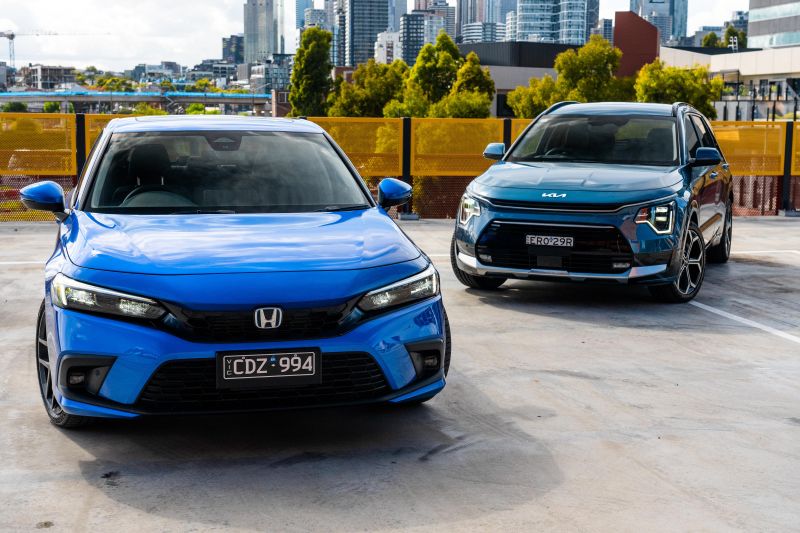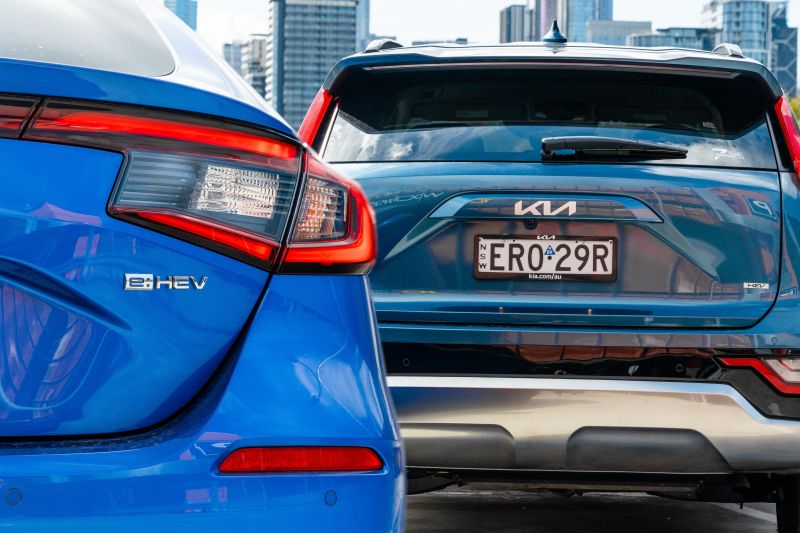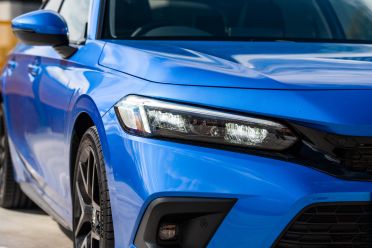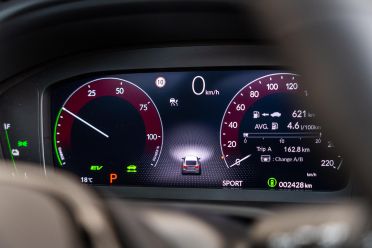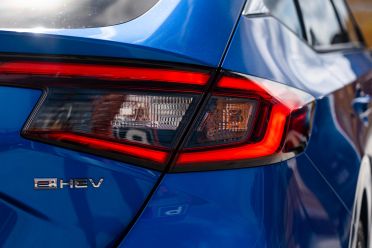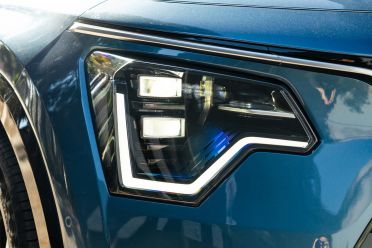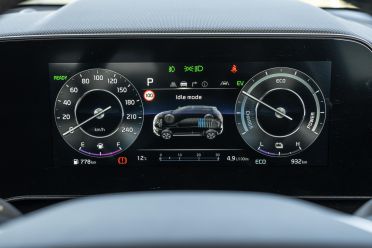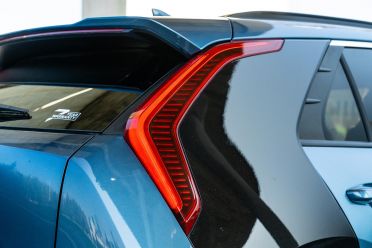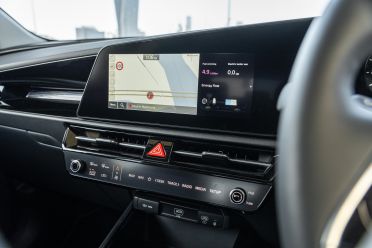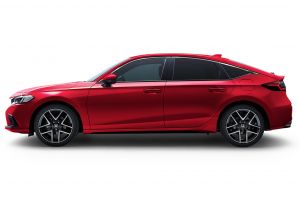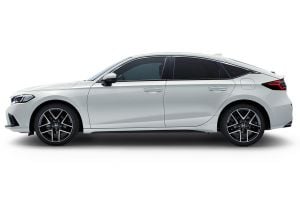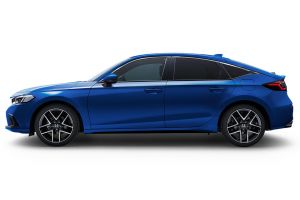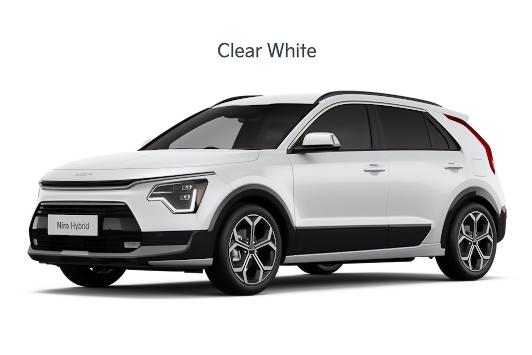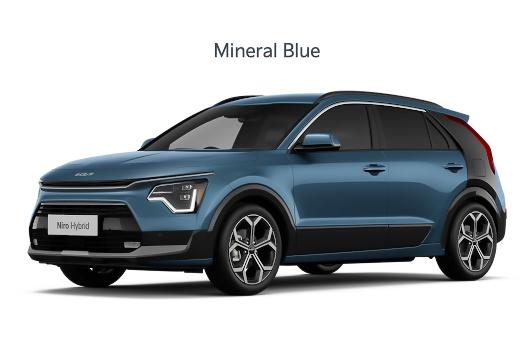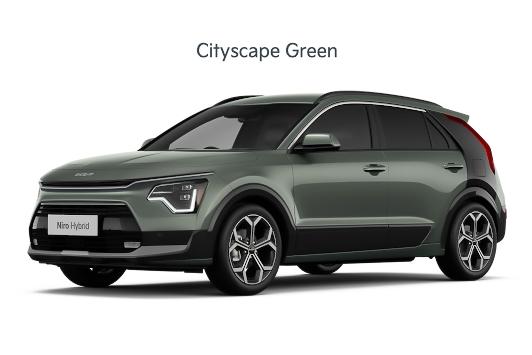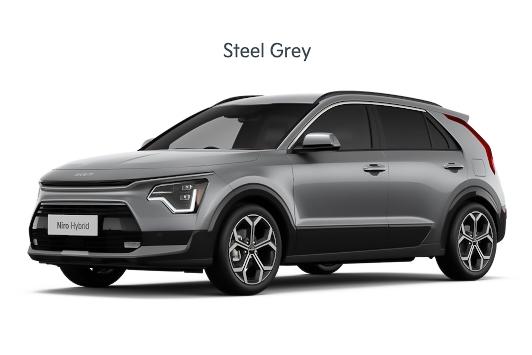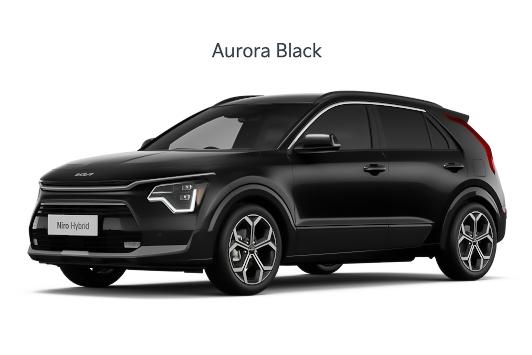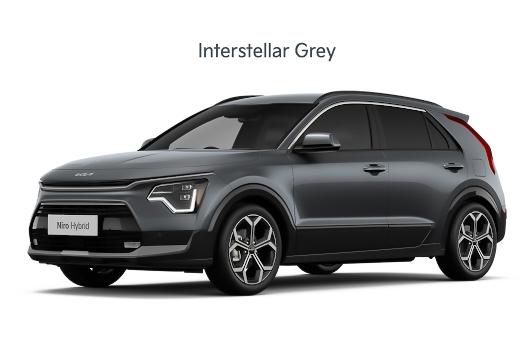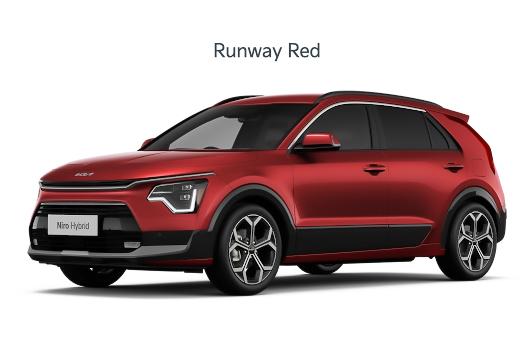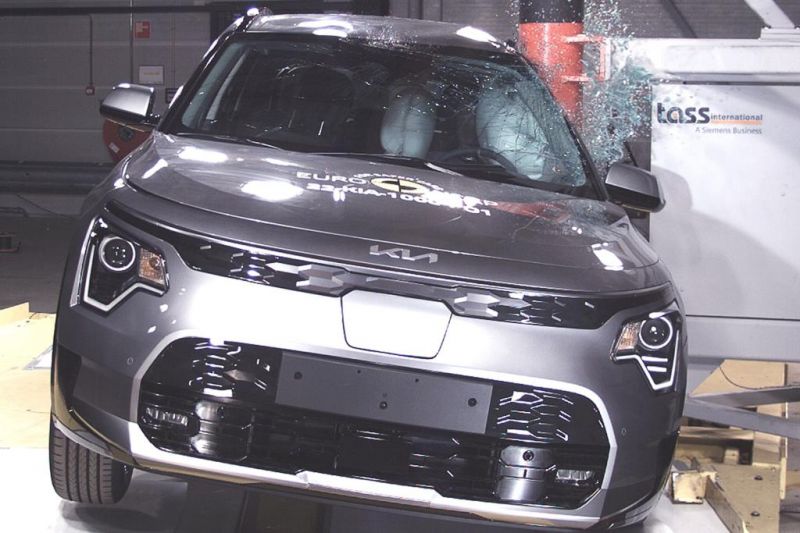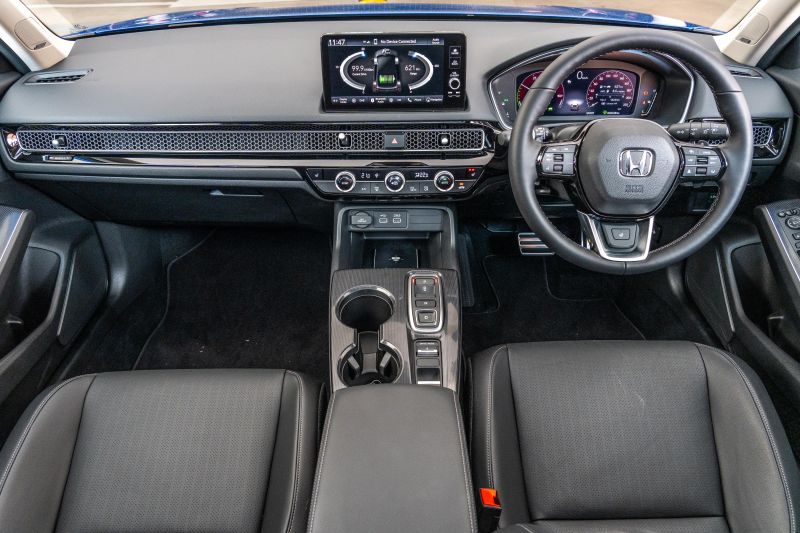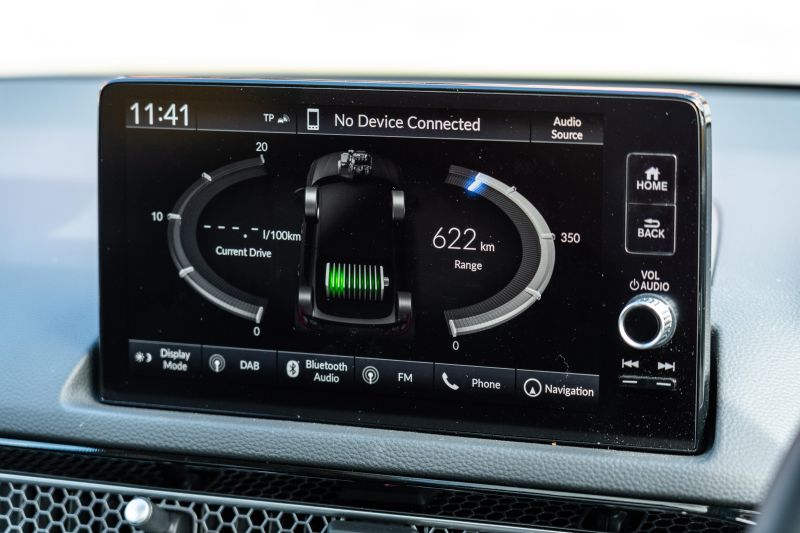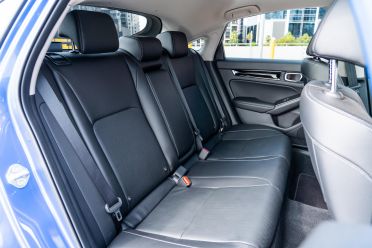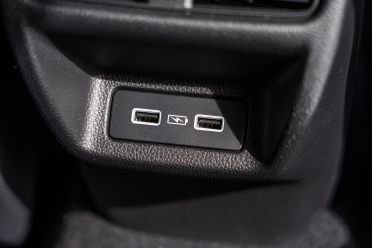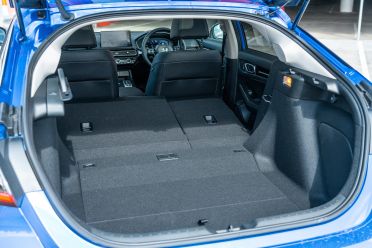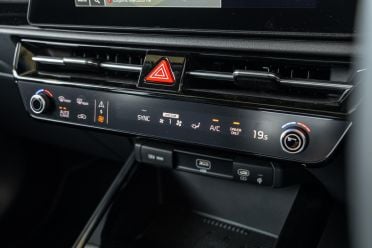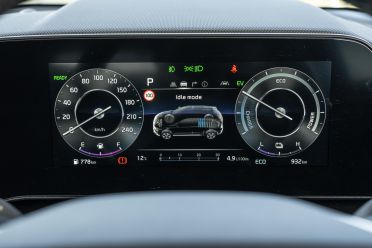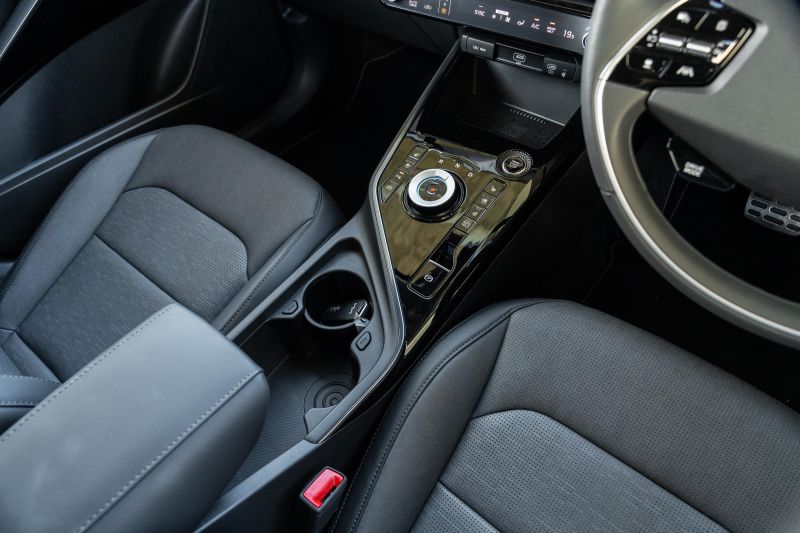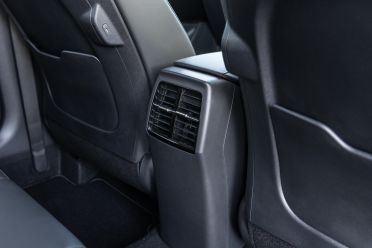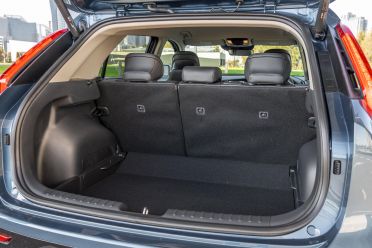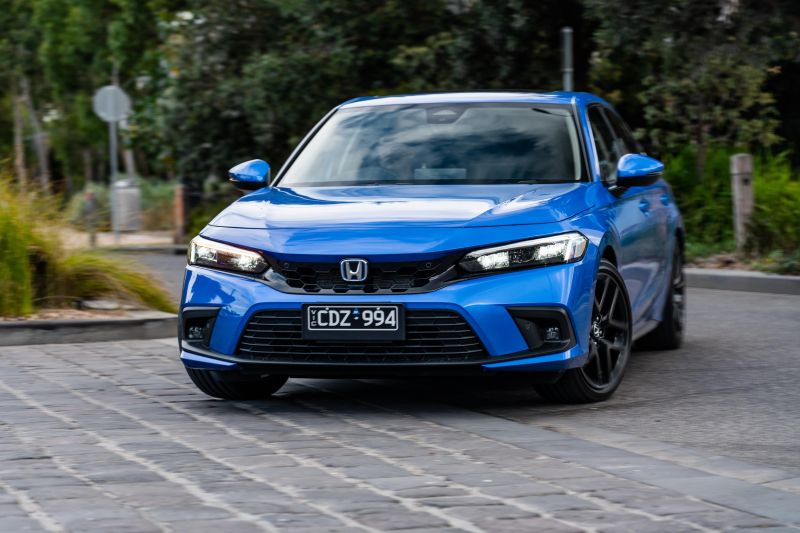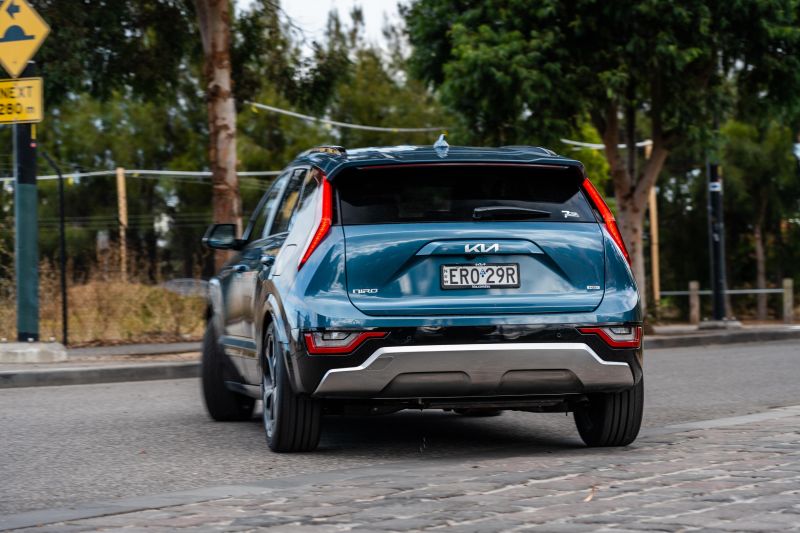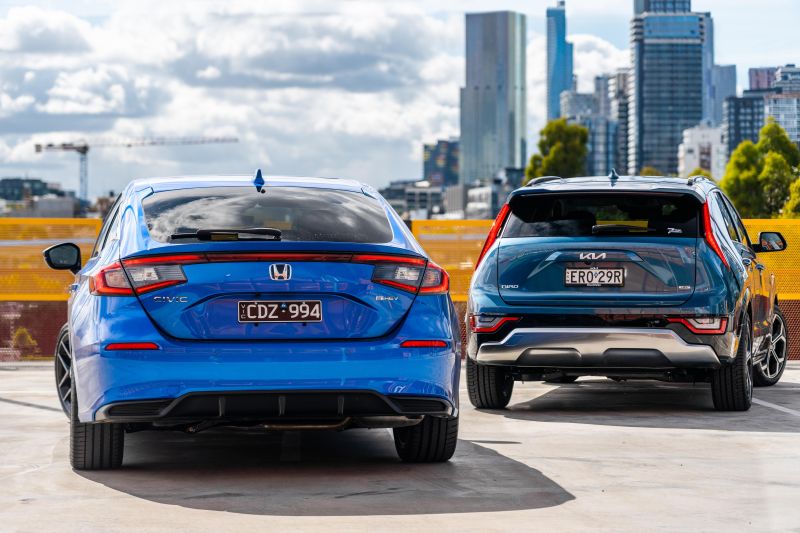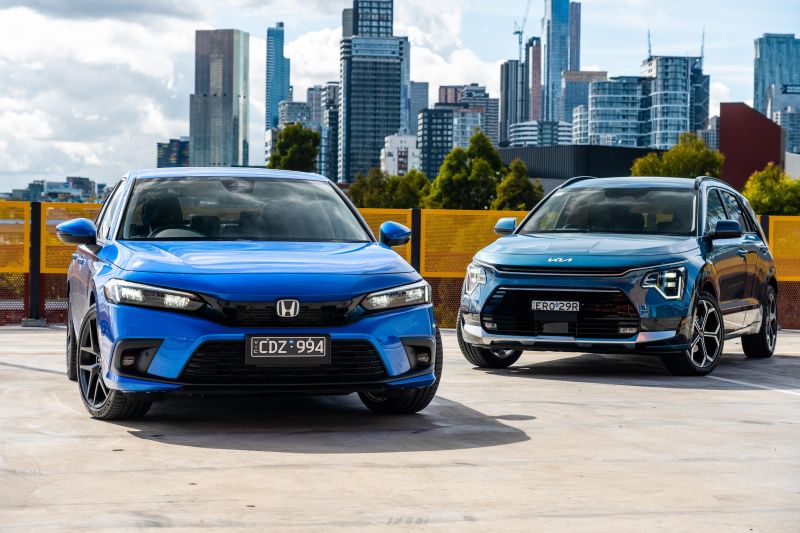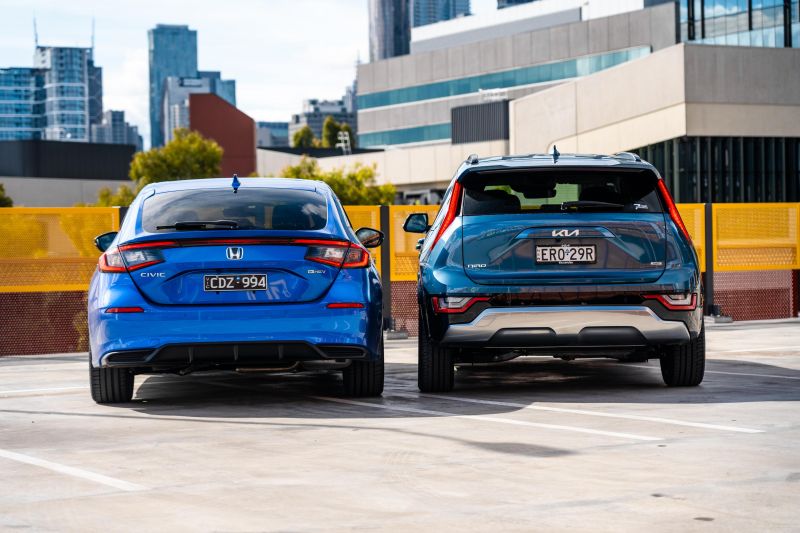So you want your next car to be a hybrid, but a Toyota isn’t for you…
Whether it’s down to wanting something different or not having two years to wait for a car, there’s a range of options entering the Australian market.
Here we have two very different segment-busting hybrids going for the same price as the in-demand RAV4 Cruiser 2WD Hybrid – roughly $55,000 drive-away based on a Melbourne postcode.
From Japan we have the new Honda Civic e:HEV LX, a big small car with a pretty sporty take on electrified motoring, and proof the brand has its mojo back after a decade or so of hit-and-miss motoring.
Meanwhile, Korea has entered the chat by way of the second-generation Kia Niro HEV GT-Line, a small SUV with a big interior that has the same sort of disruptive boxy design the original Soul brought to the table some 15 years ago.
If you’re not tied to a brand or body style and aren’t fazed at spending RAV4 money on something a little smaller, these are two decked-out petrol-electric cars that are fun to drive and will stand out from the Toyota crowd.
While both of these vehicles are strong offerings in their own rights, which one is better?
How much?
As noted earlier, both vehicles you see here command pretty much the same price as a Toyota RAV4 Cruiser 2WD Hybrid.
Honda’s fixed-price model sees the new Civic e:HEV LX priced at $55,000 drive-away, which is about $10,000 more than you’ll pay for a top-spec Toyota Corolla Hybrid, an more than you’ll pay for a flagship Camry Hybrid.
The Civic arguably straddles the small and medium passenger segments in terms of size, and Honda’s premium-ish product pitch promises a more engaging drive and refined offering all round.
Meanwhile, the Kia Niro HEV GT-Line is positioned at the premium end of its segment. At $50,030 before on-road costs – $55,163 drive-away according to the brand’s configurator – the top-spec Niro Hybrid is about line-ball with an entry-level Audi Q3 (from $50,600).
The Niro’s closest rival, the Toyota Corolla Cross, is priced from $46,050 in equivalent Atmos 2WD Hybrid trim, which is arguably closer in positioning than the Civic relative to its main competitors. Like the Honda, the Niro is pitched as a segment-straddling offering that goes big on space and tech in a compact, and premium package.
As noted earlier, both vehicles on test match a Toyota RAV4 Cruiser 2WD Hybrid, which tends to be the default choice for hybrid transport in Australia right now.
Short supply and growing order banks mean if you try to get the in-demand Cruiser, you could be waiting up to two years for your car, and may be subject to spec changes and price adjustments in that time, as some customers have found out.
Other potential rivals include the Audi A3 35 TFSI mild-hybrid (from $47,700) for the Civic, while the Niro could be cross-shopped with a litany of electrified SUVs including the Honda HR-V e:HEV L ($47,000 D/A), the Lexus UX250h Luxury 2WD (from $52,025), the Mitsubishi Eclipse Cross PHEV Aspire (from $51,240), and the Subaru Forester Hybrid S ($49,340).
What do you get?
Honda Civic e:HEV LX highlights:
- 18-inch alloy wheels
- Auto LED headlights with auto-levelling
- Auto high-beam
- 10.2-inch HD digital driver’s display
- 9.0-inch touchscreen infotainment system
- Wireless Apple CarPlay
- Wired Android Auto
- Satellite navigation
- DAB+ digital radio
- 12-speaker Bose sound system
- Honda Connect
- Wireless phone charger
- 7.0-inch digital instrument cluster
- Leather-wrapped steering wheel
- Leather-wrapped shifter
- Leatherette upholstery with red-accented suede
- 8-way power driver’s seat
- 4-way power passenger seat
- Heated front seats
- Rain-sensing wipers, integrated washer nozzles
- Power retractable exterior mirrors
- Auto-dimming rear-view mirror
- Paddle shifters
- Alloy sports pedals
- Dual-zone climate control
- Rear air vents
- Tilt and telescopic steering wheel adjustment
- Panoramic glass sunroof
- Leather-appointed seat trim
- Heated steering wheel
- 8-way power driver’s seat incl. lumbar
- 4-way power passenger seat incl. lumbar
- Heated steering wheel
- Active Noise Control
- White ambient lighting
- Rear USB charge ports x 2
- Seat back pocket – driver’s seat
- Passenger sunvisor ticket holder
- Cargo area accessory power outlet
- Front and rear parking sensors
- Bright door moulding
- High gloss black door sash garnish
Kia Niro HEV GT-Line highlights:
- 18-inch alloy wheels
- LED headlights, fog lights
- LED daytime running lights
- Rear privacy glass
- Laminated front door glass
- Automatic headlights
- Rain-sensing wipers
- Powered, auto-folding exterior mirrors
- 10.25-inch central touchscreen
- 10.25-inch digital instrument cluster
- 10.0-inch head-up display
- Satellite navigation
- Apple CarPlay, Android Auto (wired)
- DAB+ digital radio, AM/FM tuner
- Leather-trimmed steering wheel
- Paddle shifters (to control regen)
- Dual-zone climate control
- Cloth and artificial leather trim
- 6-way powered driver’s seat
- Remote Smart Park Assist
- Kia Connect app connectivity
- Keyless entry and start
- Artificial leather seat trim
- Heated, ventilated front seats
- Heated steering wheel
- Gloss black exterior mirror trim
- Metal scuff plates, pedals
- Gloss black interior trim highlights
- Front ambient lighting
- Wireless phone charger
- Dual rear map pockets
- Two-tone paint options
Both cars here aren’t really left wanting for spec, but there are a few discrepancies and omissions worth calling out given the price point.
The Niro doesn’t have a sunroof in HEV GT-Line trim, despite it being standard in the EV GT-Line, and same goes for a premium Harman/Kardon sound system – the Civic features both, although its 12-speaker sound system comes from Bose.
Honda also offers wireless Apple CarPlay, which the high-spec Niro lacks, as well as power adjustment for both front seats.
The Kia counters with a larger infotainment display (10.25 v 9.0in), dual LED projector-type headlights over the Civic’s reflectors, and a Remote Smart Park Assist feature allowing you to pull into/out of parking spots from outside using the key.
Speaking of headlights, Honda doesn’t fit the Civic e:HEV LX with the higher-grade adaptive LED headlights are available on high-spec Civics elsewhere in the world.
Colours
Honda Civic
- Platinum White Pearlescent
- Premium Crystal Blue Metallic
- Premium Crystal Red Metallic
All finishes are no-cost options ($NCO)
Kia Niro
- Clear White
- Mineral Blue*
- Cityscape Green*
- Steel Grey*
- Aurora Black*
- Snow White Pearl*
- Interstellar Grey*
- Runway Red*
*Premium paint adds $520
Are they safe?
Honda Civic
The Honda Civic family is yet to be rated by ANCAP, though its Euro NCAP equivalent awarded the Japanese small car a five-star safety rating – in Europe only e:HEV hybrid versions are available for the core line-up.
Against 2022 protocols, the Civic e:HEV scored 89 per cent for adult occupant protection, 87 per cent for child occupant protection, 82 per cent for vulnerable road users and 83 per cent for safety assist.
Standard safety equipment includes:
- 8 airbags
- Dual front
- Dual front-side
- Dual front knee
- Curtain airbags
- Autonomous emergency braking (AEB)
- Rear cross-traffic alert
- Blind-spot monitoring
- Lane departure warning
- Lane keep assist
- Lane centring assist
- Adaptive cruise control
- Traffic Jam Assist
- Driver attention monitoring
- Reversing camera
Civic e:HEV LX adds:
- Front, rear parking sensors
- Intelligent speed limiter
- Traffic Sign Recognition System
- 11 airbags (total)
- Front centre airbag
- Rear side airbags
Kia Niro
The Niro was recently awarded a five-star ANCAP safety rating based on 2022 Euro NCAP tests.
Category scores included 88 per cent for adult occupant protection, 84 per cent for child occupant protection, 76 per cent for vulnerable road user protection, and 87 per cent for safety assist. This rating applies to all variants.
Standard safety equipment includes:
- 8 airbags incl. front-centre, driver’s knee
- Autonomous Emergency Braking (AEB)
- Pedestrian, Cyclist detection
- Junction assist
- Reverse AEB
- Blind-spot assist
- Rear cross-traffic assist
- Driver attention monitoring
- High Beam Assist (auto high-beam)
- Intelligent Speed Limit Assist
- Lane Following Assist
- Lane keep assist
- Leading Vehicle Departure Alert
- Parking sensors front, rear
- Rear Occupant Alert
- Reversing camera
- Safe Exit Warning
- Safe Exit Assist
What are they like inside?
Honda Civic
The Civic’s cockpit is definitely the more conventional and car-like of the two cars here, with a low-slung and sporty flavour that will appeal to keener drivers.
Ahead of the driver is a 10.2-inch digital instrument cluster, which matches the Kia’s, and the seats are leather-accented.
It offers virtual dials with configurable widgets, with crisp graphics and smooth animations. Honda’s latest products have very clean designs and consistent typefaces throughout, much like Mazda – understated and classy.
There’s a standard panoramic sunroof that lets in more light too – something the Kia lacks – and white LED ambient interior lighting to set the mood when the sun goes down.
The Civic e:HEV’s powered front seats offer a good range of movement, and are supportive and comfortable for long or short stints behind the wheel.
They’re heated with electric lumbar support too. The steering wheel also gets heating, which will be handy on chilly Melbourne mornings no doubt, but the Civic misses out on the Niro’s ventilated pews.
A new drive-by-wire gear selector debuts in the Civic e:HEV, which the company says is inspired by the unit used by the NSX hybrid supercar. I’m not sure if pushing a button is as satisfying as using a conventional shifter or the Niro’s rotary shift-by-wire selector.
The free-standing 9.0-inch touchscreen navigation system features Honda Connect online services, which offers a range of services that are accessible via a smartphone app, incorporating convenience and safety functions.
Beyond the connected functions, the touchscreen system features native satellite navigation, wireless Apple CarPlay, wired Android Auto, Bluetooth phone and audio streaming, AM/FM/DAB+ radio.
There’s support for over-the-air (OTA) updates for both maps and system software too, and Honda offers five years of free map updates, which can be done over Wi-Fi rather than requiring a visit to the service centre.
The Kia’s 10.25-inch infotainment system sounds more substantial on paper, but Honda’s unit is competitive overall. Wireless Apple CarPlay in the Honda is another tick for the Civic, as the Niro doesn’t offer wireless smartphone with its higher-end infotainment option.
There are two USB-A ports, a 12V outlet and a standard wireless phone charging pad. There’s also decent storage in the door bins and under the front-centre armrest.
While the Civic is one of the roomiest small cars in the second row, it’s not our pick of this pair if you’re planning on using these hybrids as a family car or substitute for something as large as a RAV4.
I’m 6’1 and can sit behind my own driving position just fine, despite the sloping roofline and panoramic sunroof, but that roofline and the tapered windows mean the back seats don’t feel quite as airy or accommodating as the boxier Niro.
The Civic offers less knee room as well behind my preferred driving position than the Kia, and the floor feels higher relative to the seat so you have a more knees-up position. The larger driveline hump also impedes on the centre seat if you need to carry a fifth passenger.
Adding to the rear amenities are air vents, bottle holders in the doors, a fold-down centre armrest with cupholders, as well as map pockets behind the rear seats. Underneath the air vents behind the centre console are two additional USB-A chargers. You’ve also got ISOFIX anchors on the outboard seats, as well as top-tether points.
The e:HEV offers 409 litres of capacity (404L + 5L underfloor) with the rear seats in place, expanding to 1187 litres with the rear bench folded.
Like the petrol version, the Civic e:HEV doesn’t offer a spare wheel of any form, instead making do with a tyre repair kit – something to consider if you travel out of town regularly.
Both measurements lag behind then Kia, particularly when the seats are folded (1187L v 1419L). If you’re planning on lugging around kids and prams and sporting equipment, the Civic is worse off here.
Kia Niro
It’s like a mini EV6 in here.
In GT-Line spec, the Niro gets just about every feature and screen the company can throw at it, and the car’s boxy design means it feels much airier and more spacious inside than the compact exterior might suggest.
Up front you’ll feel like you’re much higher than the Civic, for a more commanding view of the road ahead. The taller body and large glasshouse also afford better outward visibility and let more light into the cabin.
The Kia feels well built with a good mix of materials and surfaces, but it’s a little… dark. Australia doesn’t get any of the light interior options available overseas, but there are soft-touch materials on the upper dash and doors, and the switchgear feels solid. I’m not crazy about the fingerprint-prone gloss black trim.
The configurable touch bar housing the infotainment and climate controls is, like in the EV6 and Sportage, one of the better examples of touch-based switchgear.
The shortcuts are arranged logically and they aren’t so small or close together that you’re constantly pressing the wrong thing on the go – plus there are knobs for volume and temperature. Switching between infotainment and climate controls is cool too, because of how quickly everything changes.
As we’ve seen with other Kia models, the Niro has its instrument cluster and infotainment display in a conjoined housing, with the displays measuring 10.25 inches each in GT-Line specification. It’s a little more new-age and glossy than the Civic’s more conventional setup, and apes premium brands like Mercedes-Benz.
Both screens offer the same look and feel as other Hyundai and Kia models, though the Niro was the first Kia in Australia to feature net-based Kia Connect services – remote engine start, app-based vehicle status, vehicle tracking, emergency call, and remote destination entry via smartphone.
The new features add a missing layer of polish to the Kia’s infotainment, which also gets 10 years of online Traffic Information services and free map updates when you service at your authorised Kia dealer.
It even has voice commands with natural voice recognition. You no longer need Apple CarPlay or Android Auto active to use the voice control button and get the vehicle to enter navigation destinations, for example.
The interface itself offers rich graphics and snappy responses, and the six-speaker audio system is good without being great. The eight-speaker Harman/Kardon-branded premium setup reserved for the Niro EV GT-Line is a better bet, however, as is the Civic’s beefier 12-speaker Bose unit.
The seats are trimmed in perforated Bio PU leatherette, and while not convincing as real cow hide, the upholstery is supple and there’s a pattern to the inserts that is visually interesting.
Drivers are treated to an eight-way powered seat with two-way electric lumbar support, though there’s no memory. There’s a good range of adjustment in the seat and the steering wheel to find a comfortable driving position.
The front passenger seat is a manual six-way unit, which seems a bit silly given the pricing and the fact it’s offered on the EV GT-Line – another small win for the Honda.
The front seats feature heating and ventilation (the Honda lacks the latter), and the steering wheel is heated.
Storage is good up front, with a configurable cubby in the centre console with cupholders, door bins that can hold decent-sized bottles, and a shelf ahead of the rotary e-shifter which also houses the wireless phone charger. This little cubby also has a USB-A port for smartphone mirroring, a USB-C charge port, and a 12V socket.
The Kia does a better job of storage than the Honda, with more cubbies and shelves that are more configurable in most cases, but also just larger in general.
While the Niro is classified by VFACTS as ‘small’ the second row is much closer in passenger space to vehicles a size up.
There’s excellent headroom thanks to the tall roofline, and there’s plenty of legroom. I’m 6’1 and can comfortably sit behind my own driving position, though the bench itself is quite flat which, while not necessarily as comfortable as the Civic’s more shapely and angled cushions, allows for more space if you’re sitting three in the rear.
Amenities include airline-style map pockets on the front seatbacks, faster USB-C charge ports on the inner sides of both front seats, rear air vents, a fold-down centre armrest with cupholders, as well as bottle holders in the rear doors.
Kids are catered for with ISOFIX anchors on the outboard seats, and top-tether points across all three positions.
Open up the GT-Line’s hands-free power tailgate and there’s 425 litres of luggage capacity, which again is a match for vehicles in the size class above and 16 litres greater than the Civic’s claim.
The area itself is wide, square and flat, and expands to an impressive 1419L with the rear seats folded. While there’s a step up to the seat backs in its max volume setting, the floor folds upwards to even out the difference in height.
Boot features include a foldable cargo cover, as well as luggage net hooks and a light.
Unlike the Civic e:HEV, which gets a tyre repair kit, the Niro HEV comes with a space-saver spare under the floor.
What’s under the bonnet?
Honda Civic
Power in the Civic e:HEV comes from a 105kW/186Nm 2.0-litre Atkinson cycle petrol engine with direct injection, teamed with a 1.05kWh lithium-ion battery and two electric motors.
System outputs are quoted at 135kW (5000-6000rpm) and 315Nm (0-2000rpm), with drive sent exclusively to the front axle via an e-CVT transmission that’s controlled by a unit that optimises the drivetrain to conditions.
The Civic e:HEV officially uses 4.2L per 100km on the combined cycle, although the claim is as low as 2.0L/100km on the urban cycle. CO2 emissions are quoted at 96g/km.
Both VTi LX petrol and e:HEV LX hybrid versions of the new Honda Civic can run on 91 RON regular unleaded fuel, and meet Euro 6b emissions certification. Fuel tank capacity for the e:HEV is listed as 40L.
Kia Niro
Power in the Niro HEV comes from a 1.6-litre naturally-aspirated petrol engine teamed with a transmission-mounted permanent magnet synchronous electric motor and a 1.32kWh lithium-ion battery pack.
The direct-injected petrol engine develops 77.2kW (5700rpm) and 144Nm (4000rpm) on its own, while the electric motor contributes a further 32kW and 170Nm – system outputs are quoted as 104kW (5700rpm) and 265Nm (4000rpm).
Drive is sent to the front wheels via a six-speed dual-clutch transmission (DCT). Kia claims the Niro HEV GT-Line should accelerate from 0-100km/h in 10.8 seconds.
The all-important fuel consumption figure is a thrifty 4.0L/100km on the combined cycle, with the Niro HEV rated to run on regular 91 RON unleaded. The fuel tank measures 42L, meaning theoretically you should be able to get 1000km on a tank. CO2 emissions for the Niro HEV are quoted at 91g/km.
How do they drive?
Honda Civic
The Civic e:HEV is the clear driver’s pick in this duo, and you get that sense from the moment you sink into its low-slung seat.
Honda says all 315Nm is available between 0 and 2000rpm, and it certainly feels that way. The hybrid Civic leaps off the line, and when you’re driving in a more spirited manner it delivers muscular performance through to the top end.
Honda quotes a rough 0-100 time of 7.8 seconds, about 3.0s quicker than the Kia. Do some searching on the YouTube and you’ll find videos of drivers getting well below 7.0 seconds for the sprint – that’s warm hatch territory, which is impressive for a vehicle that majors on efficiency.
The Honda is actually the heavier car of the pair we have on test, quoting a tare mass of 1478kg versus the Niro HEV GT-Line’s quoted 1454kg.
The keen front end and hunkered-down chassis means the Civic e:HEV corners with a verve and confidence the boxy Niro can’t match, with more grip than most owners will dare to explore. It’s quite a bit of fun to punt up a winding B-road as well as city streets.
In its Sport setting, the Civic will lets out a sporty synthesised engine note under hard throttle, which has an almost F1-like high-pitched whine to it, and simulates gear shift sounds. You have to experience it, but it’s quite a bit of fun to drive hard, unlike most hybrids which just sound like they’re complaining under load.
Once you hit the city, the Civic e:HEV has a more relaxed and efficient vibe, leaning more heavily on its electric drive and maintaining an admirable level of comfort and composure despite its more athletic bent and 18-inch alloys shod in 235/40 Goodyear Eagle rubber.
The more energy dense lithium-ion battery (compared to the nickel-metal hydride units in old Toyotas) and beefy 315Nm e-motor mean the Civic e:HEV can lean on electric power for longer and more often, allowing you to accelerate up to 50-60km/h with no petrol assistance under light throttle.
Oddly though, you can’t lock the Civic into EV mode like you can in some other hybrids. The Niro is the same, mind you.
The latest Honda Sensing features more refined and work better in the real world than previous iterations, with the adaptive cruise and traffic jam assist functions facilitating semi autonomous driving in conjunction with the lane centring assist.
Front and rear parking sensors, along with a reversing camera are good to have, but given the price we would like to see a 360-degree camera system thrown in too.
Rounding out the driver assist suite are blind-spot monitoring and rear cross-traffic alert, and not the silly LaneWatch camera Honda used to use. It feels much more polished across the board, which can only be a plus.
Kia Niro
The Niro was never going to be a match for the Civic in terms of performance, but it still offers a nice balance between comfort and driver enjoyment.
Press the starter button and the Niro comes to life in silence, as it defaults to EV mode on startup like the Honda. You can’t actually toggle hybrid mode settings like Civic though.
As we’ve noted in previous reviews of Kia hybrids, it takes a moment to get used to the feel of the brand’s electrified products, as the electric motor is mounted in the transmission and shifts through gears even when the petrol engine isn’t firing.
You can actually feel the car shifting as you build speed when the drivetrain is solely using the electric motor, which feels a little foreign at first but you quickly get used to it.
While the Niro’s outputs won’t set your pulse racing, the low-down response from the electric motor means it gets along with decent pace and doesn’t feel underpowered compared to rival hybrids.
It only really runs out of puff at the top end, given electric motors taper off at higher speeds and the petrol engine only generates 77kW at 5700rpm.
The 1.6-litre petrol engine is pleasant and reasonably refined in urban driving, but can get a little gruff if you push it. Don’t buy into the GT-Line branding, this is no performance product. If you’re looking for pace, the Civic is easily the pick.
However, the Niro does feel athletic in the way it rides and handles. With its local suspension tune and focus on dynamics with this new platform, the Niro HEV is surprisingly nippy and responsive when you point it at a bend.
Kia’s quick, direct steering teams well with the planted chassis, which makes for a bit of fun slinking through suburban streets and tight carparks.
It’s also well damped, so while it rides on the firmer side with its 18-inch alloys , it doesn’t crash and jar over imperfections like drain covers and tram tracks.
You can use the paddles on the steering wheel to control gear shifts, and there’s Sport mode for the steering and powertrain for better response. However, getting the engine to hold revs can be a little coarse and unrefined.
Slow things down a little and the Niro HEV does a pretty seamless job shuffling between power sources, and flicks itself into EV mode often.
Insulation from wind and road noise is decent without being standout. To my ear the Civic was a little quieter on the freeway by comparison.
The Niro HEV GT-Line comes equipped with an suite of assistance systems, and like other Hyundai/Kia products these features are well calibrated and quite handy in everyday use.
Blind-spot and rear cross-traffic assist are helpful on busy freeways and inner-city roads, and help to alleviate any blind spots caused from the thick C-pillars. Unfortunately there’s no Blind Spot View Monitor cameras like other high-end Kias.
The Niro’s adaptive cruise control and Lane Following Assist also take the strain off longer highway stints, managing acceleration, braking and turning within a lane. Between this and the Honda, there’s not much in it.
For all its strengths though, the lack of a 360-degree camera system in any grade is noteworthy. Given many rivals offer one, it’s disappointing the Niro’s premium pricing doesn’t buy you a camera with 3D View as we’ve seen in the company’s other products – though we have a similar complaint about the Civic.
Cost of ownership
Honda Civic
The Honda line-up is covered by a five-year, unlimited-kilometre warranty with an eight-year IMA battery module warranty for the hybrid. Additionally, there’s five years of premium 24/7 roadside assist.
On top of the warranty and roadside assist coverage, Honda guarantees five years of free satellite navigation mapping updates when you service within the network. Models with Honda Connect receive a five-year subscription to online services too.
Scheduled maintenance is required every 12 months or 10,000 kilometres – whichever comes first. Vehicles sold after October 1, 2022 are also subject to higher service costs than before, listed at $199 for the first five visits as opposed to the dirt-cheap $125 from before.
For the first five years, the Civic will cost you just $995 in servicing, which is among the cheapest in the industry – not just between the two cars here. That said, if you do more mileage you’ll be at the shop more often.
Kia Niro
The Niro, like the wider Kia range, is backed by a seven-year, unlimited-kilometre warranty. Further, the high-voltage components (e.g. battery, e-motor) are covered for seven years or 150,000 kilometres.
Scheduled maintenance is required every 12 months or 15,000 kilometres – whichever comes first.
Kia Niro HEV service pricing:
- 12mths or 15,000km: $276
- 24mths or 30,00km: $653
- 36mths or 45,000km: $370
- 48mths or 60,000km: $1035
- 60mths or 75,000km: $311
- 72mths or 90,000km: $818
- 84mths or 105,000km: $533
In total, the Niro HEV will cost $3996 over the life of the seven-year capped-price service schedule, which is a heavy whack regardless of how you look at it. Three years sits at $1299, and five years is $2645 – over 2.5 times the cost of the Honda.
Kia Australia says all service items are included in the above CPS schedule, meaning there’s no hidden costs for items like brake fluid, brake replacement, or coolant changes.
Economy
Being hybrids, fuel economy is a very important part of the consideration process.
The Civic e:HEV and Niro HEV both claim impressive combined fuel consumption – 4.2L/100km and 4.0L/100km respectively – and they both came pretty darn close to those numbers in real-world testing.
A mixed driving loop including a decent freeway jaunt yielded an indicated 4.4L per 100km in the Civic and 4.5L per 100km in the Niro. Both showed 4.4L/100km for the week which included some 300km of mixed driving for both vehicles – very impressive.
Both cars here can run on cheaper 91 RON unleaded, with the Civic e:HEV’s fuel tank measuring 40L and the Niro HEV’s 42L. Given how efficient both cars proved to be in the real world, the Niro’s extra 2L in the tank could get you almost 50km further on a fill.
CarExpert’s Pick
There are a few factors at play here when deciding which of these two hybrids is the best one for you.
I know both the Civic e:HEV LX and Niro HEV GT-Line are pricey for what they are. You can get cheaper alternatives from Toyota (if you’re willing to wait) and GWM Haval, but these definitely feel nicer and more resolved.
The Civic is better to drive than a Corolla Hybrid; and the Niro feels more premium and unique compared to something like a Corolla Cross Hybrid. Both are also more efficient than the top-selling RAV4 Hybrid which has Australian customers queueing out the door and down the street.
If you don’t want your switch to electrified motoring to be boring, the Civic is the better car. It’s fun to drive and blows the Kia (and most Toyotas) out of the water with its performance. It’s like a budget BMW 3 Series it’s that good behind the wheel.
If the SUV look and practicality are key selling points, the Niro gives you a lot of what larger alternatives offer, in a funky package with more premium interior presentation. It also has that seven-year warranty – even if servicing is a little pricey – which gives you peace of mind for longer.
For the purposes of this twin test, I have to give the gong to the Civic e:HEV.
While I have a soft spot for the Niro’s cool design and packaging, the Civic’s superior performance and dynamics, longer list of premium features, and dirt-cheap servicing are hard to beat.
There’s something really special about how the Civic feels from behind the wheel, and it’s a stunner in the Crystal Blue Metallic we have on test. You might have to wait at least nine months for one, though.
Click the images for the full gallery
MORE: Everything Honda Civic
MORE: Everything Kia Niro



